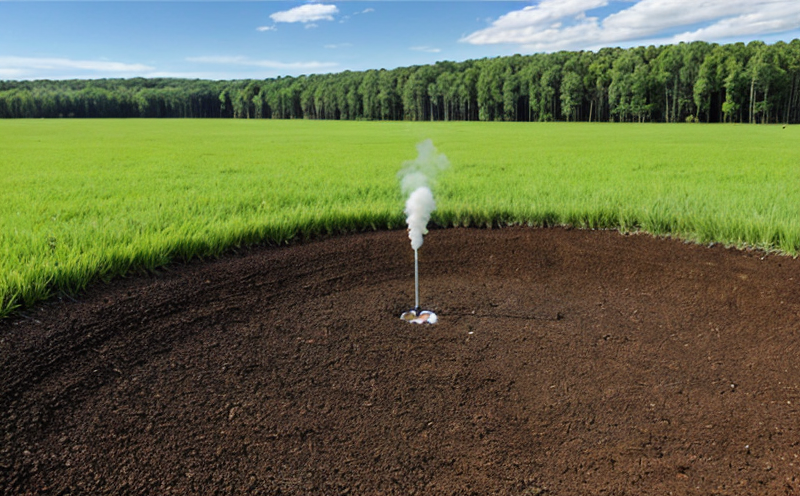ASTM D6234 Leachability of Mining Waste Testing
The ASTM D6234 leachability testing method is a critical process used to evaluate the potential release of contaminants from mining waste materials into the environment. This test ensures that mining operations are in compliance with environmental regulations and helps protect public health by identifying potential risks associated with improper disposal or storage of tailings.
The ASTM D6234 standard specifies procedures for determining the leachability of metals, metalloids, and other pollutants from solid waste materials. It is widely used across various sectors including mining, construction, and hazardous waste management industries to ensure that leachable concentrations are within acceptable limits set by regulatory bodies such as the U.S. Environmental Protection Agency (EPA).
During this testing procedure, samples of mine tailings or other relevant waste materials are subjected to controlled conditions designed to simulate natural weathering processes over time. These conditions include temperature ranges between 20°C and 50°C, humidity levels ranging from 45% RH up to saturation point, and exposure periods lasting anywhere from several days to months depending on the specific requirements outlined in ASTM D6234.
The primary goal of conducting leachability tests according to ASTM D6234 is twofold: first, it provides valuable information regarding how quickly and under what circumstances contaminants might be released into surrounding soil or water bodies; secondly, it helps determine appropriate strategies for managing hazardous materials so as not to pose threats either directly through contact with humans or indirectly via contaminated groundwater sources.
For accurate results, samples must undergo rigorous preparation steps which involve crushing the solid waste material down to an appropriate particle size (typically less than 2 mm), mixing it thoroughly within a defined volume of leaching solution, and then incubating it under specified environmental conditions. Afterward, analysts measure concentrations of target analytes using analytical techniques such as inductively coupled plasma mass spectrometry (ICP-MS).
This service plays an essential role in ensuring that mining activities comply with international standards like ISO 14001 regarding sustainable development practices and helps maintain a balance between economic growth and environmental protection. By providing reliable data about the leachability properties of mine waste products, this testing method supports informed decision-making processes related to proper disposal methods or long-term storage solutions.
Customer Impact and Satisfaction
The implementation of ASTM D6234 compliant leachability tests offers numerous benefits for mining companies looking to enhance their operational efficiency while simultaneously meeting stringent environmental regulations. Here are some key advantages:
- Compliance Assurance: Ensures adherence to local, national, and international standards such as those specified by the EPA or ISO 14001.
- Risk Mitigation: Identifies potential environmental hazards early on in the lifecycle of mine waste products thereby minimizing liability risks associated with improper disposal practices.
- Informed Decision Making: Provides actionable insights into the long-term stability and behavior of different types of waste materials, allowing for more effective resource management decisions.
A successful outcome translates to increased customer satisfaction among stakeholders who rely on accurate data when making strategic business choices. For example, regulatory authorities appreciate reliable testing results because they can use this information to enforce compliance measures effectively without causing unnecessary disruptions to legitimate mining operations.
Moreover, by demonstrating commitment to responsible environmental stewardship through rigorous application of ASTM D6234 standards, companies strengthen their reputation among consumers and investors alike. This enhanced image fosters greater trust within the community and enhances overall brand value.
Environmental and Sustainability Contributions
The adoption of ASTM D6234 leachability tests contributes significantly to environmental sustainability by promoting responsible management practices for mining waste materials. Below are some specific ways in which this service supports broader sustainability goals:
- Reduction in Pollution: By identifying and mitigating sources of pollution early on, companies can prevent the release of harmful substances into ecosystems.
- Resource Conservation: Proper disposal methods advocated by ASTM D6234 help conserve natural resources by ensuring that only necessary amounts are extracted from the earth.
- Biodiversity Preservation: Minimizing contamination helps preserve local flora and fauna which may otherwise face extinction due to habitat destruction caused by improper waste management practices.
Incorporating ASTM D6234 into routine quality assurance protocols not only aligns with corporate social responsibility initiatives but also enhances overall competitiveness in the global market. Companies that demonstrate leadership in sustainability tend to attract more customers who share similar values, leading to increased sales and profitability over time.
Use Cases and Application Examples
The ASTM D6234 leachability test finds extensive application across various mining operations where there is a need to assess the environmental impact of waste materials. Here are some typical use cases:
| Use Case | Description |
|---|---|
| Evaluation of Tailings Storage Facilities | Assesses the potential for metals and metalloids leaching into nearby water bodies from storage facilities. |
| Landfill Design Optimization | Helps in designing landfills that minimize the risk of contamination by optimizing liner systems and leachate collection. |
| Treatment Process Monitoring | Monitors treatment processes to ensure they are effectively reducing contaminant levels before final discharge into the environment. |
| New Material Development | Used during research & development phases to evaluate new materials for their environmental compatibility before commercialization. |
| Risk Assessment | Performs comprehensive risk assessments of existing or proposed mining sites based on predicted leachate concentrations and associated health impacts. |
| Sustainable Mining Practices | Supports the adoption of sustainable practices by providing data needed to implement best management practices for waste disposal. |
The versatility of ASTM D6234 makes it applicable not only within traditional mining operations but also in related industries such as construction and hazardous waste management. Its ability to provide precise measurements of leachable components allows stakeholders to make informed decisions about the most effective strategies for managing waste materials.





